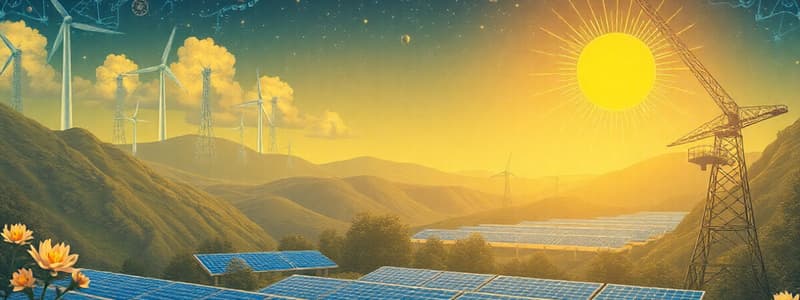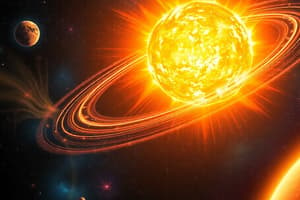Podcast
Questions and Answers
What is a key advantage of nuclear power production?
What is a key advantage of nuclear power production?
- Large land area requirement
- Complex waste disposal process
- Clean energy source (correct)
- High carbon emissions
Which of the following accurately describes breeder reactors?
Which of the following accurately describes breeder reactors?
- They are designed for low energy output
- They only use uranium as fuel
- They consume more fissile material than they produce
- They produce more fissile materials than they consume (correct)
What is a common disadvantage of nuclear power?
What is a common disadvantage of nuclear power?
- Low energy density of uranium
- High availability of resources
- Easy public acceptance
- Significant initial construction costs (correct)
Which state produces the highest percentage of electricity from nuclear power?
Which state produces the highest percentage of electricity from nuclear power?
Which factor significantly contributes to the public perception issues regarding nuclear power?
Which factor significantly contributes to the public perception issues regarding nuclear power?
What characteristic of selenium allows it to be transparent to light at certain photon energies?
What characteristic of selenium allows it to be transparent to light at certain photon energies?
What is the primary material used to construct majority of photovoltaic cells?
What is the primary material used to construct majority of photovoltaic cells?
How is a solar cell structured to become a module or an array?
How is a solar cell structured to become a module or an array?
What is the primary function of the p-n junction in a solar cell?
What is the primary function of the p-n junction in a solar cell?
Which of the following materials is identified as having high toxicity issues in photovoltaic applications?
Which of the following materials is identified as having high toxicity issues in photovoltaic applications?
What is a drawback of using amorphous silicon in thin film technology for solar cells?
What is a drawback of using amorphous silicon in thin film technology for solar cells?
What process does the photoelectric effect depend on?
What process does the photoelectric effect depend on?
What is required for a photovoltaic system to effectively power various applications?
What is required for a photovoltaic system to effectively power various applications?
What is the primary function of photovoltaic (PV) cells?
What is the primary function of photovoltaic (PV) cells?
Which of the following statements about solar panels is true?
Which of the following statements about solar panels is true?
What is the significance of the solar constant value of approximately 880 W/m2 at the earth's surface?
What is the significance of the solar constant value of approximately 880 W/m2 at the earth's surface?
Which feature distinguishes direct radiation from diffuse radiation?
Which feature distinguishes direct radiation from diffuse radiation?
What advancement does NASA's Glenn Research Center focus on regarding solar cells?
What advancement does NASA's Glenn Research Center focus on regarding solar cells?
Which type of solar collectors are used to absorb solar energy for heating purposes?
Which type of solar collectors are used to absorb solar energy for heating purposes?
How does solar energy contribute to energy independence for small countries?
How does solar energy contribute to energy independence for small countries?
What is a significant disadvantage of solar energy systems?
What is a significant disadvantage of solar energy systems?
Which process generates the energy that fuels the sun?
Which process generates the energy that fuels the sun?
What factors can affect the efficiency of solar cells?
What factors can affect the efficiency of solar cells?
What is the primary purpose of Breeder Reactors?
What is the primary purpose of Breeder Reactors?
Breeder Reactors are often mistakenly identified as what type of energy source?
Breeder Reactors are often mistakenly identified as what type of energy source?
Which nuclear fusion reactor uses lasers for inducing fusion reactions?
Which nuclear fusion reactor uses lasers for inducing fusion reactions?
What type of isotopes does the MIT Sparc Reactor use to initiate fusion?
What type of isotopes does the MIT Sparc Reactor use to initiate fusion?
What is a common feature of tokamak fusion devices?
What is a common feature of tokamak fusion devices?
Which of the following is NOT considered a renewable energy source?
Which of the following is NOT considered a renewable energy source?
In the context of renewable energy, what characteristic defines hydroelectric energy?
In the context of renewable energy, what characteristic defines hydroelectric energy?
What is the main limitation of using tidal energy?
What is the main limitation of using tidal energy?
Which of the following benefits are associated with solar energy?
Which of the following benefits are associated with solar energy?
What technological advancement is being pursued in thin film technology for solar cells?
What technological advancement is being pursued in thin film technology for solar cells?
What is the primary function of a solar module in a solar photovoltaic system?
What is the primary function of a solar module in a solar photovoltaic system?
What role does the inverter play in a solar photovoltaic system?
What role does the inverter play in a solar photovoltaic system?
Which component is responsible for preventing battery overcharging in a solar photovoltaic system?
Which component is responsible for preventing battery overcharging in a solar photovoltaic system?
What has been identified as a disadvantage of solar electricity?
What has been identified as a disadvantage of solar electricity?
How does solar energy contribute to energy security?
How does solar energy contribute to energy security?
What is a potential benefit of advancements in thin film technology?
What is a potential benefit of advancements in thin film technology?
What is one key characteristic of solar photovoltaic systems regarding maintenance?
What is one key characteristic of solar photovoltaic systems regarding maintenance?
Which of these is NOT a benefit of solar electricity?
Which of these is NOT a benefit of solar electricity?
What is the purpose of the battery in a solar photovoltaic system?
What is the purpose of the battery in a solar photovoltaic system?
Which of the following statements about solar energy's environmental impact is true?
Which of the following statements about solar energy's environmental impact is true?
Flashcards
Single-crystal silicon cell
Single-crystal silicon cell
Most common type of photovoltaic cell, made from refined and purified silica (SiO2).
p-n junction
p-n junction
The part of a solar cell where the doped silicon layers meet, creating the electrical reaction.
Solar cell module
Solar cell module
Multiple solar cells connected together to provide increased power.
Photovoltaic (PV) system
Photovoltaic (PV) system
Signup and view all the flashcards
Photoelectric effect
Photoelectric effect
Signup and view all the flashcards
Amorphous Silicon
Amorphous Silicon
Signup and view all the flashcards
Cadmium Telluride
Cadmium Telluride
Signup and view all the flashcards
Solar Cell Efficiency
Solar Cell Efficiency
Signup and view all the flashcards
Renewable Energy
Renewable Energy
Signup and view all the flashcards
Solar Energy
Solar Energy
Signup and view all the flashcards
Solar Panels
Solar Panels
Signup and view all the flashcards
Solar Constant
Solar Constant
Signup and view all the flashcards
Flat Plate Collectors
Flat Plate Collectors
Signup and view all the flashcards
Photovoltaic (PV) Cells
Photovoltaic (PV) Cells
Signup and view all the flashcards
Conversion Efficiency
Conversion Efficiency
Signup and view all the flashcards
Incident Solar Radiation
Incident Solar Radiation
Signup and view all the flashcards
Energy Independence
Energy Independence
Signup and view all the flashcards
Solar Radiation Components
Solar Radiation Components
Signup and view all the flashcards
Solar Module
Solar Module
Signup and view all the flashcards
Solar Charge Controller
Solar Charge Controller
Signup and view all the flashcards
Battery
Battery
Signup and view all the flashcards
Inverter
Inverter
Signup and view all the flashcards
PV System
PV System
Signup and view all the flashcards
Solar Energy Cost
Solar Energy Cost
Signup and view all the flashcards
Energy Security
Energy Security
Signup and view all the flashcards
Job Creation
Job Creation
Signup and view all the flashcards
System Applications
System Applications
Signup and view all the flashcards
Maintenance
Maintenance
Signup and view all the flashcards
Breeder Reactor
Breeder Reactor
Signup and view all the flashcards
Fusion Reactor
Fusion Reactor
Signup and view all the flashcards
Tokamak Fusion Device
Tokamak Fusion Device
Signup and view all the flashcards
Wendelstein 7-X
Wendelstein 7-X
Signup and view all the flashcards
National Ignition Facility (NIF)
National Ignition Facility (NIF)
Signup and view all the flashcards
MIT SPARC Reactor
MIT SPARC Reactor
Signup and view all the flashcards
Nuclear Fusion
Nuclear Fusion
Signup and view all the flashcards
Wind Energy
Wind Energy
Signup and view all the flashcards
Tidal Energy
Tidal Energy
Signup and view all the flashcards
Nuclear Energy Percentage
Nuclear Energy Percentage
Signup and view all the flashcards
Nuclear Power Advantages
Nuclear Power Advantages
Signup and view all the flashcards
Nuclear Power Disadvantages
Nuclear Power Disadvantages
Signup and view all the flashcards
Nuclear Waste
Nuclear Waste
Signup and view all the flashcards
Study Notes
Renewable Energy
- Renewable energy sources are crucial due to dwindling fossil fuel reserves
- Global fossil fuel reserves and consumption data shows declining reserves
- Atmospheric CO2 levels have risen significantly above historical norms
- Global average temperatures have increased steadily since 1880, correlating with CO2 levels
- Global sea levels have risen by 17cm in the last century with a recent acceleration
- Arctic sea ice has decreased substantially over several decades
- Extreme weather events like heavy rains, droughts, and heat waves have increased in frequency
- Over 95% of climate scientists agree that human activity is the cause of global warming
- Sustainable energy sources and reducing carbon emissions are crucial
- Energy independence is important for smaller countries like Ireland
- Solar energy is plentiful and globally available
- A 140x140 mile plot of U.S. land covered in solar cells could meet the entire U.S. electricity needs
- Sunlight provides significant potential for home heating
- The amount of solar energy received on a typical home can meet 1/3 to 1/2 of the heating needs
- Solar efficiency is currently only around 1% of total U.S. renewable energy
- Sunlight is the catalyst for the photoelectric reaction
Photovoltaic (PV) Cells
- Solar energy conversion efficiency is the percentage of solar energy converted into electrical energy
- Single Crystalline Silicon cells have 14% efficiency
- Thin Film cells have 7% efficiency
- New multi-junction solar cells using selenium bonding layers can reach 40% efficiency
- Solar cells produce direct current (DC)
- Solar energy efficiency depends on sunlight intensity
- Selenium's transparency to certain light wavelengths is important for efficiency
Single-Crystal Silicon PV Cell Construction
- Most PV cells are single-crystal silicon
- Silica is refined and purified to make the wafers needed for electric conduction and thin wafers
- Wafers are doped with either negative or positive type layers, creating the p-n junction
- Numerous cells are joined to form modules or arrays, dictated by sunlight availability
- Solar cell size is dependent upon sunlight in a given area
Solar Cell Modules
- A solar cell is the building block of a PV system, producing 0.5 - 1V of direct current
- Modules combine solar cells to generate more power; arrays are large modules
- Structures allow modules to face the sun efficiently
- Converters convert DC power to AC, powering various needs like pumps, commercial sites, or entire communities
Photoelectric Effect
- The effect depends on light striking metal surfaces, releasing electrons
- In the p-n junction, phosphorus (n-type) and boron (p-type) doped silicon wafers create electron flow across the junction
- Electrons traveling through an external circuit create electricity from the n-side to the p-side
Modern Materials for Thin-Film PV Technology
- Amorphous silicon is a non-crystalline silicon used in early thin-film cells
- Cadmium telluride (CdTe) is used as a p-type material, but has toxicity concerns
- Copper indium gallium selenide (CIGS) is another potential material, less common in use today
Nuclear Fusion and Fission
- Nuclear fusion joins small nuclei into larger ones, requiring high temperatures and pressures (e.g., stars)
- Nuclear fission splits large nuclei into smaller ones, usually with high-energy neutrons
- Iron is the "dead end" of both nuclear fusion and fission
Nuclear Energy - Natural Uranium
- Atomic number is the number of protons in an element
- Atomic weight is the average mass of naturally occurring isotopes
- Uranium-235 (235U) is the fissile isotope of uranium, making up less than 0.72% of naturally occurring uranium
Nuclear Energy - Fission
- Neutrons striking 235U nuclei cause them to split, releasing energy
- This can create a chain reaction by producing more neutrons for further reactions.
Anatomy of a Nuclear Power Plant
- Containment structures and shielding prevent radiation from reaching areas outside the reactor core
- Coolant absorbs heat generated in the reactor
- Steam drives turbines, generating electrical energy in generators
Fuel Processing
- Uranium mining and processing produce various waste streams
- Fuel production involves processing uranium and producing new fuel for reactors
- Spent fuel reprocessing is used to recover fissionable isotopes from spent fuel
Capacity Factor
- Capacity factors represent the percentage of time a power plant operates at full rated capacity for various fuel types and technologies
U.S. Electricity Production (2013)
- Various sources (natural gas, coal, nuclear) contribute to the overall electricity generation in the U.S.
Other Renewable Energy Sources
- Wind, tide, hydroelectric, geothermal
Studying That Suits You
Use AI to generate personalized quizzes and flashcards to suit your learning preferences.
Related Documents
Description
Test your knowledge on key concepts related to nuclear and solar energy production. This quiz covers advantages, disadvantages, and technical aspects of both energy sources. Enhance your understanding of breeder reactors, photovoltaic cells, and the factors influencing public perception of nuclear power.




